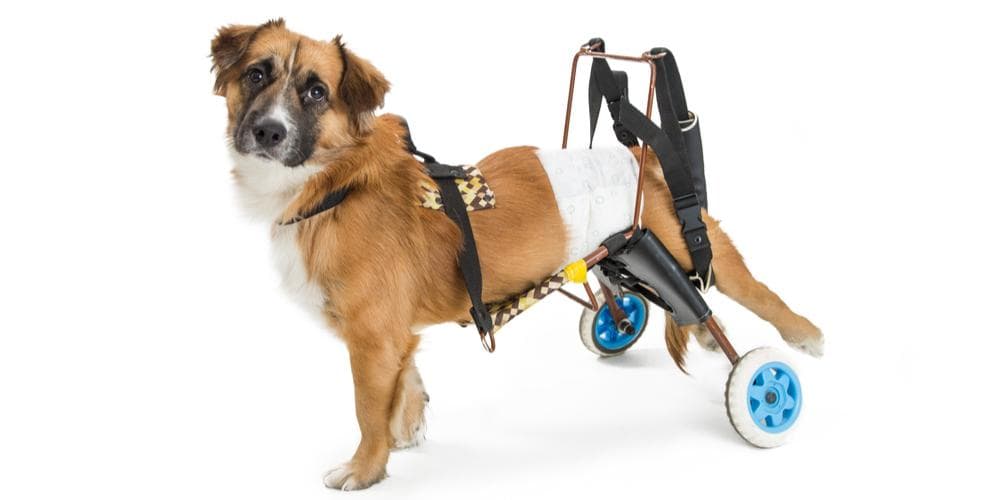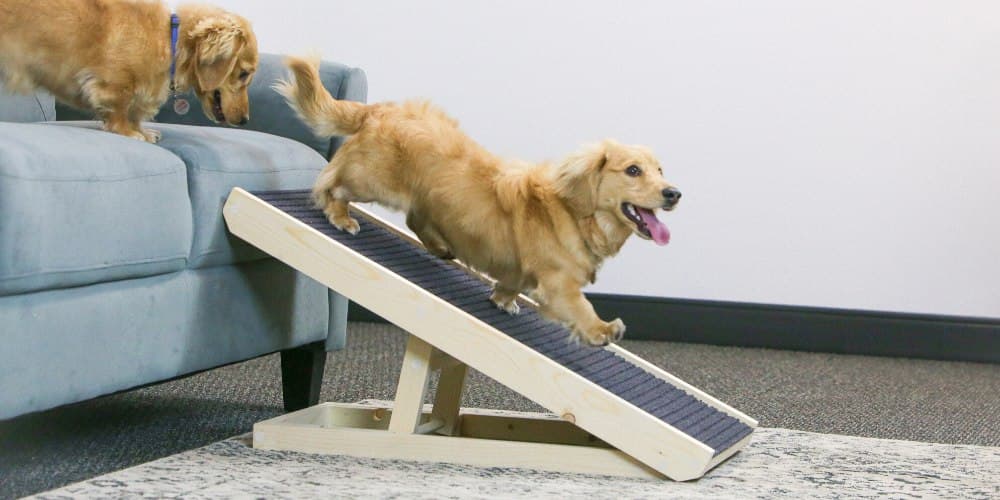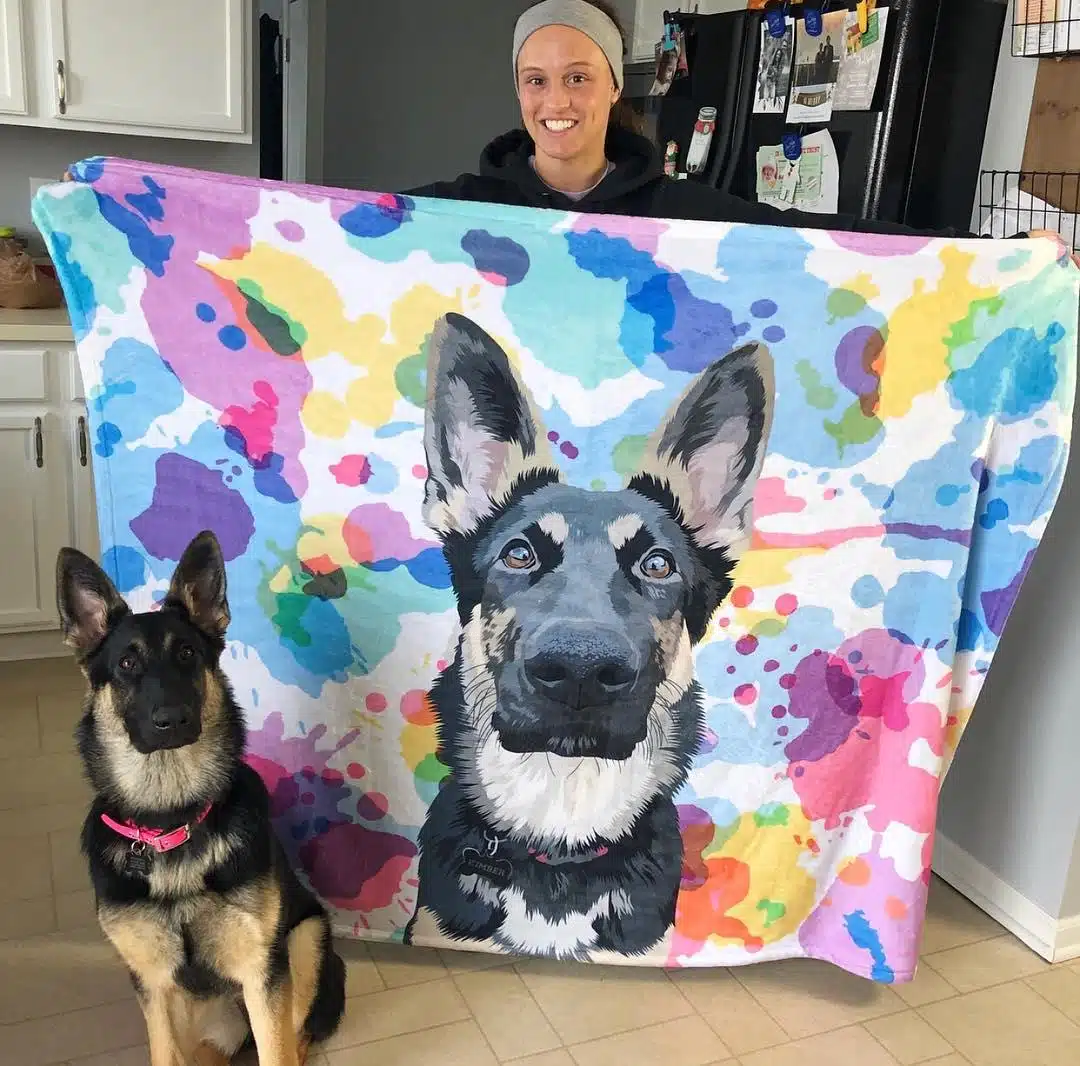What Is IVDD?
Does your dog belong to one of the top 10 breeds exposed to IVDD? Intervertebral Disc Disease is a crippling disease that is common in dogs with longer spines, heavier set weight, or underlying physical conditions.
Watch Dr. Ross’s Review on Dog Ramps It is a herniated or slipped disc on the spine caused by excessive and constant jolts of pressure, most commonly caused by jumping off of elevated surfaces such as couches and beds.
Bad jumping habits like this can very well lead to permanent damage, and temporary solutions such as wheelchairs are used for dogs who suffer from the most common result of this disease, paralysis.
#10 German Shepherd
Although deemed as athletic and explosive, German Sheperd’s hyper tendencies and youthful build do not mix well with the structure of their long spines. Although most cases of IVDD within German Shepherds aren’t serious, back injuries and issues are definitely common in this breed.
#9 Labrador Retriever
Labrador Retrievers are in a very similar case to German Shepherds. Aside from their behavior, the bone and joint structure in their legs are slightly smaller in proportion to their spines, causing more weight and pressure to be added to their discs. IVDD typically catches up to this breed as they get older.
#8 Pekingese
These extremely small dogs get the rough end of the stick with IVDD. Their stubby legs and long spine work against each other. This breed also tends to see IVDD come into the picture with age, but it is also not atypical to see this breed suffer from this disease.
Although their lack of speed and agility help prevent them from injury, they are definitely one of the more common breeds to get IVDD.
#7 Poodle
Although it is not common to think about, poodles actually have one of the longer spines in dogs in comparison to average-sized dogs. IVDD in poodles is not a stranger to these breeds, striking them most commonly at the beginning of the second half of their lives.
#6 Cocker Spaniel
A smaller dog with an elongated back. Their legs allow the boldness and opportunity to jump on and off higher surfaces, which ultimately works against the health of their spine. This breed also lies on the lesser side of athleticism in terms of build and body type, making Cocker Spaniels a very prone breed to IVDD.
#5 French Bulldog
This breed is known for its heavier bodies. With their weight and shorter legs, the infamous combination inflicts an unfortunate amount of damage to their backs, making French Bulldogs a very common breed prone to IVDD, despite the fact that their backs are pretty proportionate to their bodies.
IVDD Survivor Story – Hannah & Louis
#4 Beagle
Even though their legs aren’t typically on the stubbier side, an iconic feature in all beagles is the length of their backs. Their legs can be long enough to jump on and off furniture, creating more wiggle room for injuries and stress to their backs.
#3 Shih-Tzu
Shih-Tzus are prone to many illnesses, including IVDD, because of the way they are bred. It is very common to see young puppies taken down by IVDD. Their backs are very vulnerable and sensitive to added weight and pressure. There isn’t much lumbar support within these breeds which causes a frequent amount of suspension on their back.
#2 Corgi
Corgis are cursed with possibly the worst combination of features to have when it comes to the susceptibility of IVDD. Their weight, stubby legs, and the length of their back all come into play. Corgis are one of the most common breeds to suffer from the symptoms of IVDD with their odd posture and energy.
#1 Dachshund
The breed that suffers more than any other breed, the Dachshund. Their profoundly long backs make them the most diagnosed dog by a long shot. One in every four dachshunds will suffer from IVDD in their life. A dachshund disc can slip simply from how they are held.
3 Ways to Prevent Preventing IVDD in Dachshunds IVDD
#3 Control Weight
To the human eye, seeing a dog that is overweight may seem cute and adorable, but realistically that is an irresponsible pet owner (based on the breed of dog). Added weight puts more stress and pressure right to dogs’ joints, muscles, and especially their spines.
Obese dogs can’t exercise as much, creating more exposure to weakening their entire body. Dogs who are overweight are very susceptible to IVDD, so monitoring diet and eating habits are very crucial not only to your dog’s spine health but overall health.
#2 Use a Harness
Leashes that solely wrap around your dog’s neck are a death wish for dogs that are prone to IVDD. The yanking and tugging are very harmful to their spinal structure and adds an unnecessary amount of pressure to their backs. A harness that wraps around their bodies creates an equal distribution of weight when tugging occurs.
#1 The PawRamp
The PawRamp is the most common and trending product for dog owners that want to prevent IVDD in their dogs. It provides safe and easy access on and off elevated surfaces like beds and couches, preventing any sort of high-impact injuries caused by jumping.
It has adjustable heights, making it versatile for any type of surface you want your dog to have access to within your household. Learn more about dog ramps by clicking here.
80% of Dogs Develop Arthritis or Joint Pain by 7 Years old – Here’s How to Protect Them
Most of us train our dogs when they are puppies to jump up on furniture. We think it’s harmless (and easier than always lifting them), but for dogs, couches and beds are very high compared to the size of their bodies.
Every time they jump it compresses their back and applies enormous force to their joints.
It’s no wonder that an incredible 80% of dogs experience arthritis or joint pain by only 7 years old.
Luckily, there is a vet-recommended solution.
It’s the PawRamp by Alpha Paw. An adjustable ramp that allows dogs to safely get on and off couches and beds. PawRamp makes joining you in bed or on the couch effortless and fun.
As a bonus, you can use code SAVE35 to get $35 off the PawRamp today.













